Saint Therese of the Child Jesus
of the Holy Face
Entries by Maureen O'Riordan (555)
St. Therese of Lisieux - the hundredth anniversary of the first exhumation of her body on September 6, 1910
Today is the centenary of the first exhumation of the relics of St. Therese of Lisieux. On September 6, 1910 the body of Sister Therese of the Child Jesus was exhumed from her grave in the Carmelite plot at the municipal cemetery at Lisieux for the first time. Therese had been buried here on the morning of October 4, 1897 after a funeral Mass at Lisieux Carmel. A small funeral procession followed her body to the cemetery that day. Her sister Leonie led them, since her uncle, Isidore Guerin, was ill. Isidore had recently bought this plot in the town cemetery for the use of the Carmelite nuns, and his niece Therese was the first to be buried there.
It was to this grave that the first pilgrims came, many to give thanks for favors and cures received from God through the intercession of Sister Therese. Some miracles took place at the tomb. On May 25, 1908, the mother of little Reine Fauquet, a four-year-old girl from Lisieux who was blind, brought her child to Therese's tomb. The next day the child's vision was suddenly restored. Dr. La Neele, Therese's cousin by marriage, who did not favor the introduction of her cause, nevertheless had to sign a certificate attesting to the cure. (See Therese and Lisieux by Pierre Descouvement and Helmut-Nils Loose. Toronto, Ontario: Novalis, 1996, p. 316).
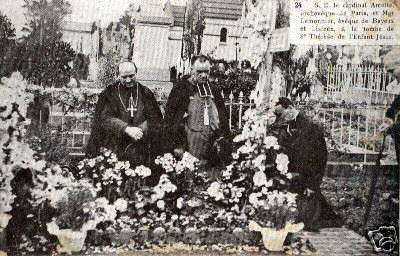 Bishop Lemonnier of Bayeux prays with the Archbishop of Paris at Therese's grave.
Bishop Lemonnier of Bayeux prays with the Archbishop of Paris at Therese's grave.
Though Therese had died less than thirteen years before, the process to inquire into her sanctity was already underway. The tribunal convened by the bishop of the diocese of Bayeux had begun in August 1910 to interview witnesses at Lisieux.
The custom of exhuming the body of a person who might be declared a saint was rooted in the time when the Church considered, among other criteria, whether the body of the candidate had been preserved. Because the Church has found that incorruptibility may be caused by environmental conditions, exhumation is no longer necessary.For more about this question see the article by Dwight Longenecker.
The night before Therese's exhumation, she appeared to Mother Carmela of the Heart of Jesus, the prioress of the Carmel of Gallipoli in Italy. Mother Carmela was not aware that the body of Therese was to be exhumed in France the next day. She reported that Therese's "countenance was very beautiful and shining, her garments glittered with a light as of transparent silver." Therese said to her "Only my bones will be found." (See Storm of Glory: The Story of St. Therese of Lisieux, by John Beevers. New York: Doubleday, 1955, p. 128). [For an account of the miracles God worked through Therese in 1910 and 1911 to rescue the Carmel of Gallipoli from near bankruptcy, please see "The Miracle of Gallipoli" by Giovanni Ricciardi. This miracle confirmed her little way and was given a special session in the diocesan process].
The exhumation of Sister Therese's body took place in the presence of Bishop Lemonnier, the bishop of Bayeux, and of about a hundred other people. Dr. de Corniere and Dr. La Neele, who looked after Therese in her illness, were present and confirmed that her body had disintegrated in the usual way soon after her death. Therese had said "You will not find me anything but a little skeleton." Her sister Pauline recorded that on August 20, 1897, Therese had said to her, "with a happy and mischievious air: 'I shall soon be in the horrors of the tomb! And you will be there also, little Mother! And when I see you arrive next to me, my humbled bones will leap with gladness!' (See St. Therese of Lisieux: Her Last Conversations. Washington, D.C.: ICS Publications, 1977, p. 156).
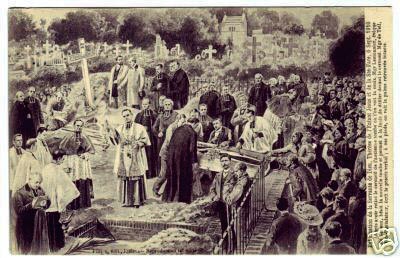 The first exhumation of the body of the Servant of God, Sister Therese of the Child Jesus of the Holy Face, at the Lisieux cemetery on September 6, 1910
The first exhumation of the body of the Servant of God, Sister Therese of the Child Jesus of the Holy Face, at the Lisieux cemetery on September 6, 1910
Only the bones covered with bits of cloth remained. But the palm branch that had been placed inside when she was buried was still fresh and green, as it is today. Was this God's way of confirming that God had granted Therese's desire to win "the palm of martyrdom"? "that thus I may become a martyr of Your love, O my God!"
 Souvenirs of the first exhumation: the palm branch; bits of the coffin
Souvenirs of the first exhumation: the palm branch; bits of the coffin
Pauline wrote that on July 3, 1897 she said to Therese: "When you are dead, they will place a palm in your hand." Therese answered, "Yes, but I'll have to let it go whenever I want to, in order to give graces by the handful to my little Mother. I will have to do everything that will be pleasing to me." (See Last Conversations, p. 72).
The gravediggers noticed the scent of violets that came from the rotting boards of the decaying casket. (Therese and Lisieux, p. 310). Dwight Longenecker mentions the remarks of one of the witnesses to the exhumation about this scent.
Today the same cross, now enclosed in stone and glass, that marked Therese's first grave from 1897 through 1910 marks the site where that first grave was. The statue nearby marks the site of her second grave.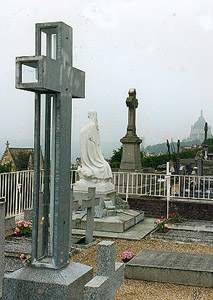 Part of the Carmelite plot in the town cemetery. The cross marks the site of Therese's first grave (1897-1910); the statue marks her second grave (1910-1923).
Part of the Carmelite plot in the town cemetery. The cross marks the site of Therese's first grave (1897-1910); the statue marks her second grave (1910-1923).
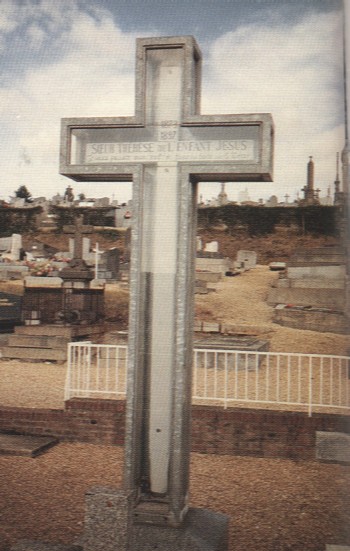 The cross has the words "I want to spend my heaven in doing good on earth."
The cross has the words "I want to spend my heaven in doing good on earth."

After this first exhumation, Therese's body was reburied in a cemented vault in a different burial plot near the center of the Carmelite plot.
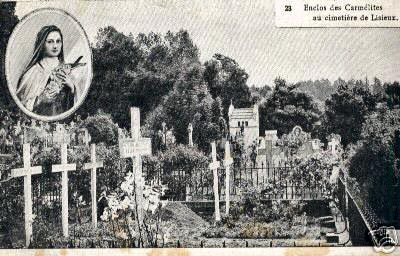 The second grave of Sister Therese of the Child Jesus of the Holy Face (1910-1923).
The second grave of Sister Therese of the Child Jesus of the Holy Face (1910-1923).
As Therese's fame spread, growing numbers of pilgrims came to visit this second grave.
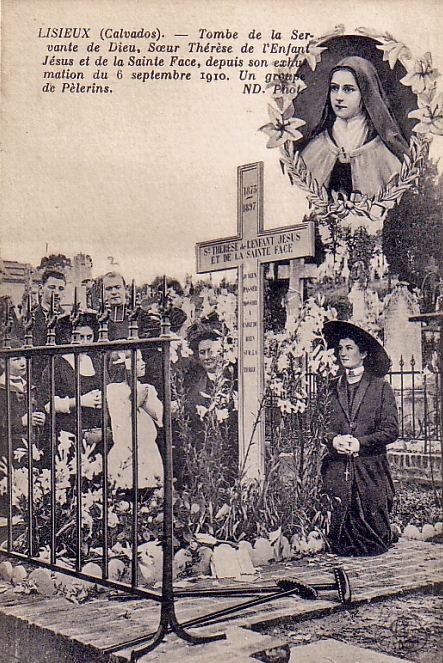 Pilgrims pray at the second grave of St. Therese. Many who had been cured through the intercession of Therese left their crutches and canes there in thanksgiving.
Pilgrims pray at the second grave of St. Therese. Many who had been cured through the intercession of Therese left their crutches and canes there in thanksgiving.
The cross that marked this second grave is on display today at the "parcours Theresien," a beautiful display of objects associated with Therese at the Lisieux Carmel.
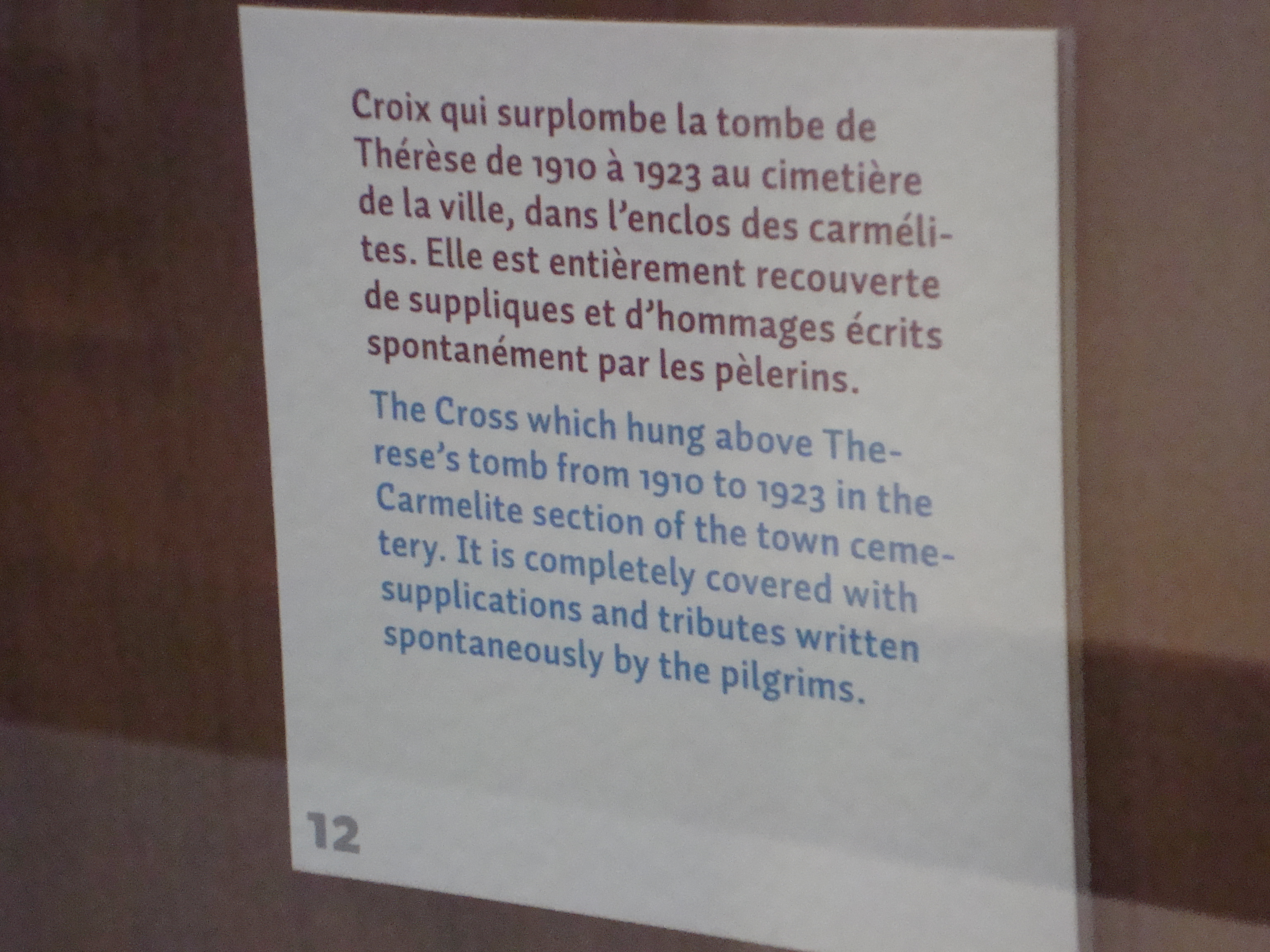 A notice from the "parcours Theresien," an exhibit pilgrims may visit at the Lisieux Carmel
A notice from the "parcours Theresien," an exhibit pilgrims may visit at the Lisieux Carmel
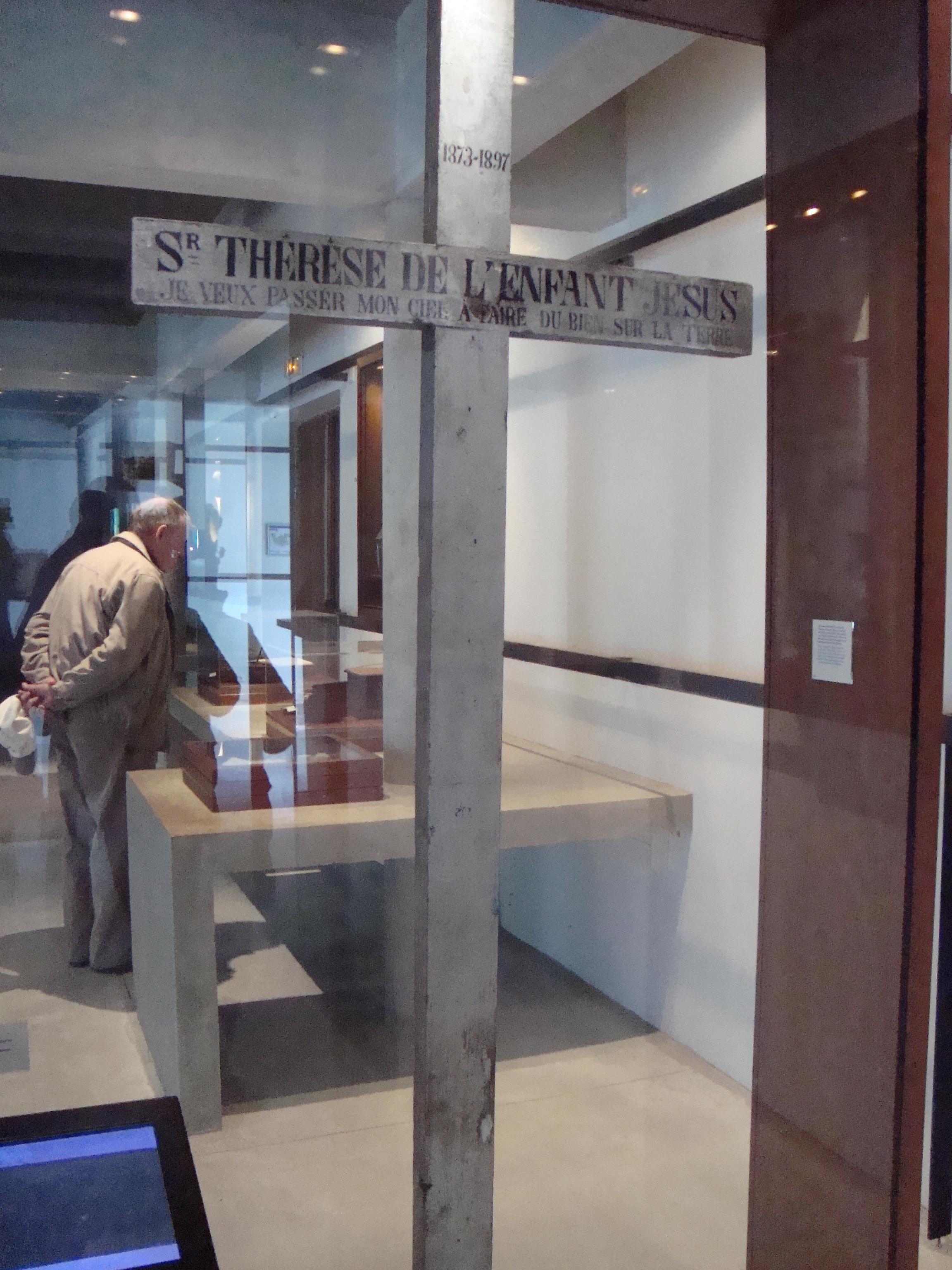 On exhibit in the "parcours Theresien" at Lisieux Carmel, the cross that marked Therese's second grave (1910-1923)
On exhibit in the "parcours Theresien" at Lisieux Carmel, the cross that marked Therese's second grave (1910-1923)
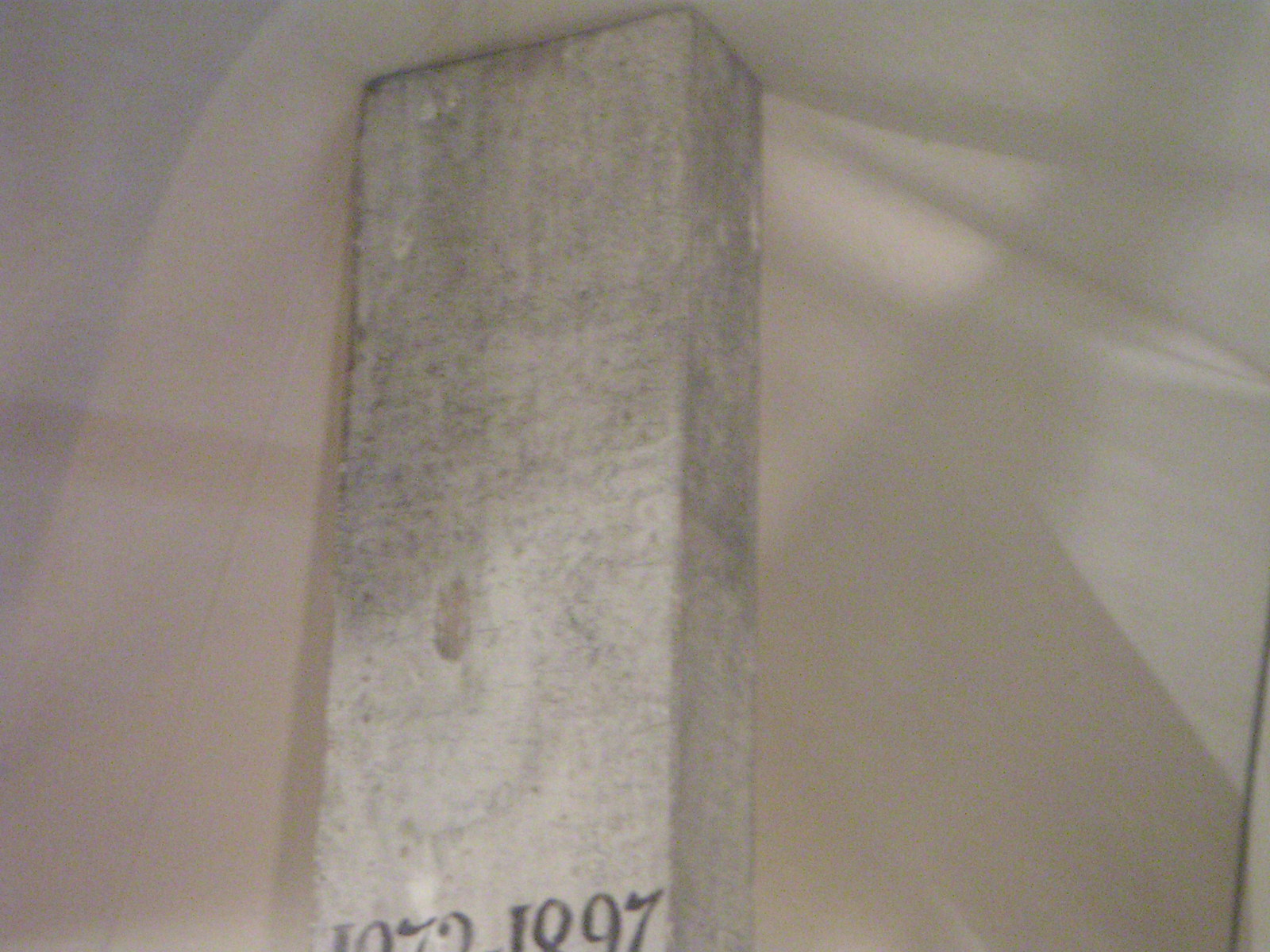 Pilgrims scribbled their petitions and thanksgivings all over the cross.
Pilgrims scribbled their petitions and thanksgivings all over the cross.
Today a statue marks the site of Therese's second grave, where her body remained until it was returned to Carmel on March 26, 1923, a month before she was beatified.
 Statue marking the spot in Lisieux cemetery where Therese was buried, 1910-1923
Statue marking the spot in Lisieux cemetery where Therese was buried, 1910-1923
At the base of the statue are written (in French) Therese's words "My God, You have surpassed my expectations, and I want to sing of Your mercies."
Several other Carmelites are also buried in the plot where Therese's second grave was, including her prioress, Mother Marie de Gonzague; her novice mistress, Sister Marie of the Angels; and Mother Marie-Ange of the Child Jesus, who entered Lisieux Carmel after Therese's death. Profoundly convinced of Therese's sanctity, she petitioned Bishop Lemonnier on the very day of her election as prioress in 1908 to open the cause of Therese, and he granted her petition.
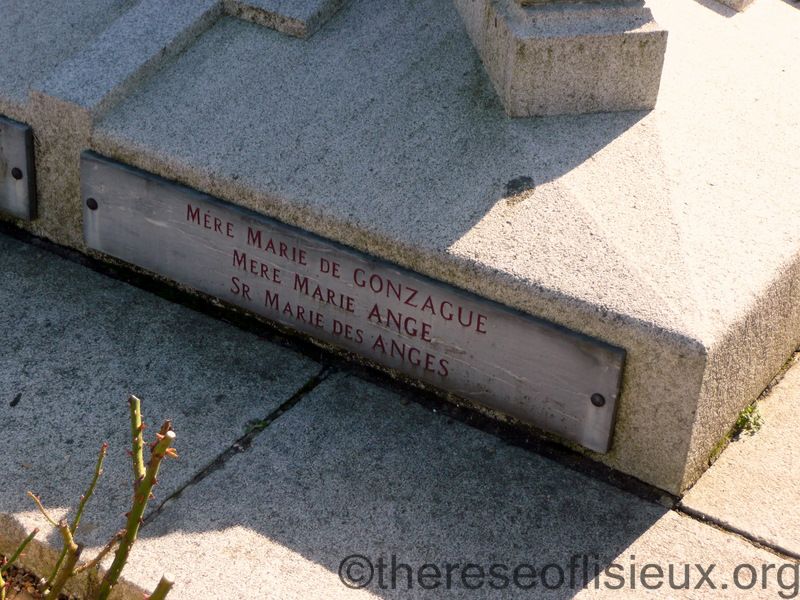 Plate bearing the names of three nuns buried in the same plot: Mother Marie de Gonzague, Therese's prioress; Sister Marie of the Angels, Therese's novice mistress; and Mother Marie-Ange of the Child Jesus, a prioress who entered after Therese's death
Plate bearing the names of three nuns buried in the same plot: Mother Marie de Gonzague, Therese's prioress; Sister Marie of the Angels, Therese's novice mistress; and Mother Marie-Ange of the Child Jesus, a prioress who entered after Therese's death
Three of Therese's novices, Sister Martha of Jesus, Sister Marie-Madeleine of the Blessed Sacrament, and Sister Marie of the Trinity, are also buried here.

Mme. Tifenne, a friend of the Martin family from Alencon and the godmother of Therese's sister Leonie, maintained that this statue resembled Therese more than any other. (See Collected Little Flower Works by Rev. Albert Dolan. Chicago: Carmelite Press, 1929, p. 160.
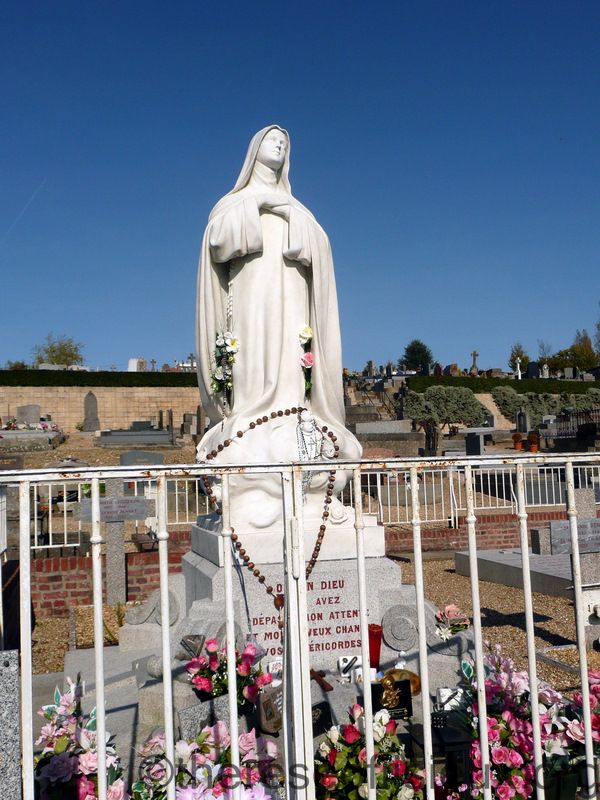 Statue marking the site of Therese's second grave in the plot her uncle bought in the town cemetery for the Carmelites
Statue marking the site of Therese's second grave in the plot her uncle bought in the town cemetery for the Carmelites
As we pass through the years leading up to the centenary of Therese's canonization, we will celebrate the centenary of many important events, including the close of the diocesan process, the opening of the cause at Rome, the Apostolic Process, the second exhumation, the declaration of Pope Benedict XV that Therese practiced heroic virtue (on which occasion he delivered a long proclamation recommending her way of confidence and love to the whole Church), the solemn translation of Therese's relics to the Carmel, her beatification, and her canonization. May they be occasions of grace for the whole world.
For permission to use photos I thank the late Fr. J. Linus Ryan and photographers Peter and Liane Klostermann, Juan Marrero, and Jesus Moreno Pacheco.
Bishop Guy Gaucher's long-awaited comprehensive biography of St. Therese of Lisieux was published on August 19, 2010!
August 19, 2010. Today is a great day for those who love St. Therese of Lisieux. "Sainte Therese de Lisieux 1873-1897: Biographie," the long-awaited comprehensive biography of St. Therese of Lisieux by Bishop Guy Gaucher, O.C.D., who edited the centenary edition of her works, was released in French by Editions du Cerf in Paris today. Its 690 pages offer an astonishingly detailed look at the life and environment of St. Therese. Click on the image below to learn more or to order it.
The "New Centenary Edition" in eight volumes (Editions du Cerf, 1992), yielded a mass of documents that permit a refinement of our knowledge of the everyday life of St. Therese of Lisieux. Nearly twenty years later, one has tried to write a biography of the Carmelite for a vast public, identifying much more closely the family, Carmelite, and ecclesial context of her life that permits us to understand the texts of the youngest doctor of the Church. At the end of her "giant's course" [Manuscript A, 44v], we can see that the sanctity of Therese ignored the illusions of a "disembodied spirituality," but was rooted in "the truth of life [Ms A, 31 v°].
Monseigneur Guy Gaucher, Carmelite, is auxiliary bishop emeritus of Bayeux and Lisieux after having been bishop of Meaux. First a specialist in Bernanos, he has consecrated his work to the figure and the writings of Saint Therese of the Child Jesus of the Holy Face. Among his many literary works about St. Therese, he participated in the New Centenary Edition of the Works of Saint Therese. [translated from the Web site of Editions du Cerf].
Meditations on the anniversary of the death of Blessed Louis Martin, father of St. Therese
Blessed Louis Martin, the father of St. Therese of the Child Jesus of the Holy Face, died on Sunday, July 29, 1894 at Chateau La Musse near Evreux.
A meditation for the anniversary of his death from his niece, Marie Guerin, later Sister Marie of the Eucharist in the Carmel of Lisieux:
In May 1895, when Marie returned to Chateau La Musse for the first time after her uncle's death, she wrote to her cousin, Louis's daughter Celine: "I made my little pilgrimage as soon as I had alighted from the carriage. I have been in my uncle's room, and there all the memories came back to me. I saw it all again . . . I was overwhelmed with the impression that there, in that chamber, something so great had taken place; that there my uncle had seen God and had been so well received. It seemed to me that I was also going to see something of Heaven, and my uncle has given me this thought, when thinking of the particular judgement: "Judge not, and you will not be judged!"
On July 28, 1895, the vigil of the first anniversary of his death, Marie Guerin wrote again: "I cannot pass by that room without being seized, in spite of myself, with a solemn, calm feeling that speaks to me of the other world and fills my soul. That happens to me very often and without any preparation on my part. I am "seized"--it is the correct word to use. I do not now why but this anniversary, sad in itself, has not at all that effect upon me. I feel so sure that my uncle entered Heaven that day, that I have rather a feeling of happiness when I think of his deliverance. How happy he is now, but he has well deserved it . . . ! Tomorrow, I mean to ask many graces from him, and I am sure I shall obtain them on that day. When one recalls, and has imprinted on one's mind his beautiful expression, calm and full of such happy peace, it is impossible not to be led to love God." (Story of a Family, by Stephane-Joseph Piat, O.F.M. New YorK: P. J. Kenedy & Sons, 1947, pp. 417-418).
7 rue Labbey, last home of Blessed Louis Martin, the father of St. Therese of Lisieux
On the vigil of the feast of Blessed Louis and Zelie Martin, a commemorative plaque was dedicated to mark the house at 7 rue Labbey, Lisieux, where Louis lived after he left the Bon Sauveur hospital in Caen in May 1892. Susan Ehlert and the house's present owners, Mme. Anne-Marie Hervieu and M. Jacques Hervieu, graciously made available photos of the house and plaque and a film of the ceremony, including a view of the garden where Louis spent so much time. See film and photos of the dedication of the plaque at 7 rue Labbey.
"Beatos Celia Guerin y Luis Martin: Compañeros en nuestro Viaje"
The article "Blessed Zelie and Louis Martin: Companions on Our Journey," by Maureen O'Riordan, appears in Spanish as "Beatos Celia Guerin y Luis Martin: Compañeros en nuestro Viaje" to celebrate the second feast of the blessed parents of St. Therese of the Child Jesus of the Holy Face. This article was first published to celebrate their beatication in 2008. Special thanks to Teolindo Garcia for translating it into Spanish.
